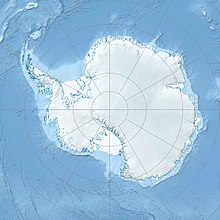Filchner station
Coordinates: 77 ° 6 ′ S , 50 ° 24 ′ W
The Filchner station was a German research station in the Antarctic . It was erected in 1982 on the Filchner-Ronne Ice Shelf in the southern Weddell Sea . The station was named after the geographer and explorer Wilhelm Filchner (1877–1957).
In 1998 the iceberg A-38 , which was several thousand square kilometers in size and on which the station, which was unoccupied at the time, stood, detached itself from the ice shelf . In a rescue operation in February 1999, the entire station was dismantled and transported to shore with the help of the Polarstern . The living containers provided space for twelve scientists and technicians, and because of the snowfall, they stood on supports that had to be raised by about one meter every two to three years. The position of the station also changed constantly, its northeast drift was about 1000 meters per year.
The Filchner station served as the basis for glaciological and geophysical investigations on the ice shelf ( Filchner Ronne Ice Shelf Program (FRISP)). It was only occupied during the Antarctic summer and was directed by the Alfred Wegener Institute . Above all, the flow properties in the ice shelf, the atmospheric input of substances into the ice and the interactions of the ice with the ocean should be investigated. In addition, an automatic weather station had been in the vicinity of the station since 1990, from which data on air pressure , temperature , wind speed and wind direction were continuously fed into an international weather data network.
The containers of the Filchner station were used again after their modernization in the interior of Antarctica. From them the Kohnen station was created , which has stood at 75 ° 00 'S, 00 ° 04' E at an altitude of 2,892 meters since 2001. A European deep ice drilling project is being carried out on Kohnen to reconstruct the climate of the Atlantic sector of Antarctica over the past 130,000 years.

